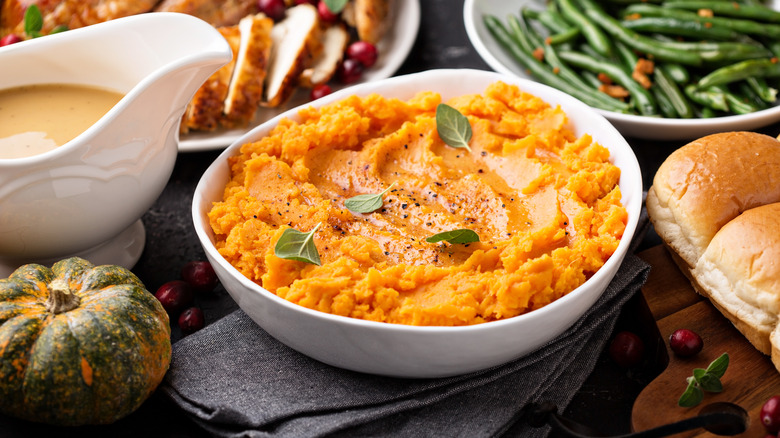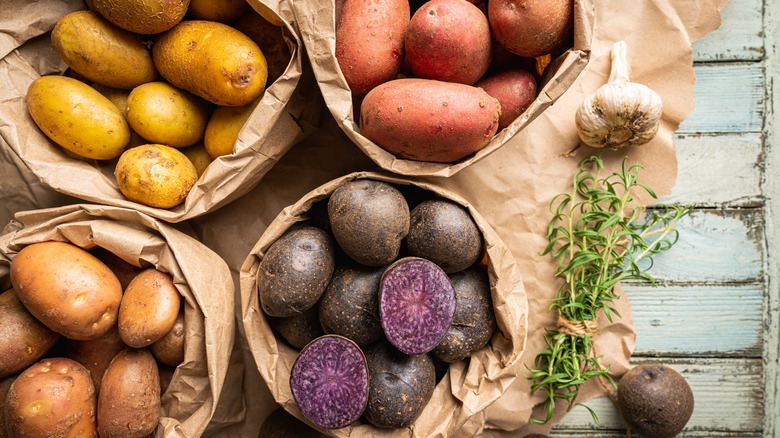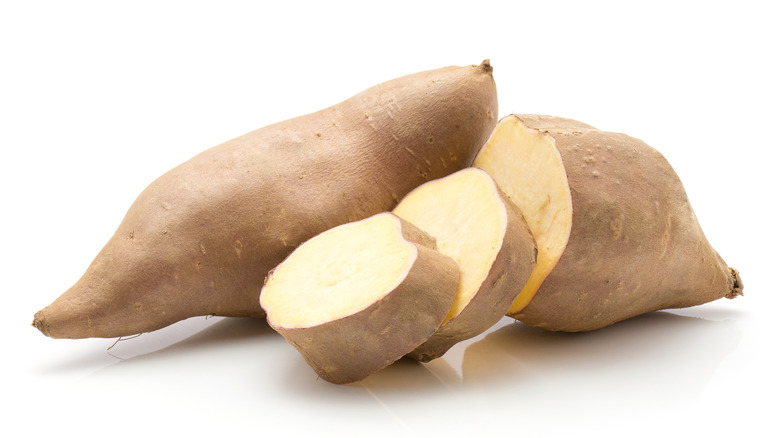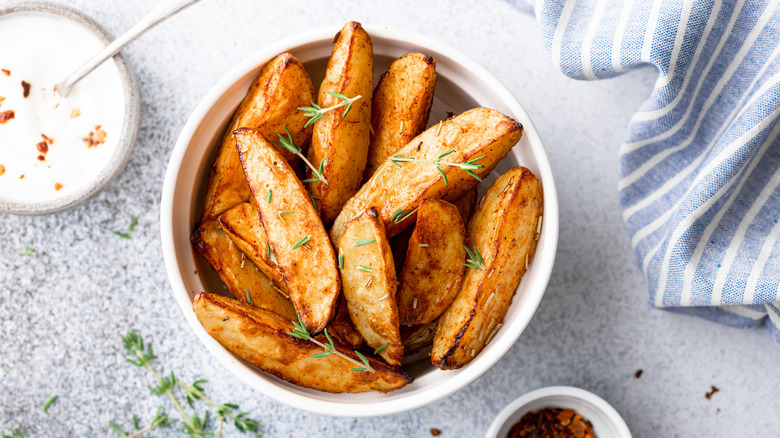Why Hannah Sweet Potatoes Shouldn't Be Substituted With Another Variety
When it comes to potatoes, there's an entire world of opportunities for how to prepare them. Whether you like 'em mashed, smashed, baked in foil, grilled, fried, or boiled in water – this is just a few of the several techniques they can undergo. Believe it or not, there are at least many different ways you can whip up these tender spuds, and a wide variety of potato types to match. International Potato Center states that there are over 4,000 varieties of potatoes that mostly originate in the South American Andes mountain ranges, with an additional 180 potato types that are considered wild.
While most white potato dishes call for a specific variety, they're typically flexible enough to be swapped in for a different kind. For instance, if you often use russet potatoes in your mashed potato recipe, it wouldn't do much damage to sub in the same amount of Yukon gold potatoes by weight. However, there are certain sweet potato recipes that should not be substituted with a variety other than the traditional orange sweet potatoes we all know, such as Beauregard, Jewel, or Red Garnet. Other unique varieties you can find at most grocery stores include Japanese sweet potatoes and Hannah sweet potatoes. Because Hannah sweet potatoes have a completely different make-up than other varieties, it's difficult for them to blend into a sweet potato pie or casserole – here's why.
Hannah sweet potatoes are far too dense
Orange sweet potatoes are the most common, making them the top variety in most sweet potato recipes. When whipping up the filling to your sweet potato pie or casserole, you're often aiming for a fluffy texture with no lumps, but Hannah sweet potatoes are quite different in the that they have a much denser texture, and actually resemble a white potato.
Hannah sweet potatoes are typically on the larger side with light brown skin and a somewhat smooth feel. When cooked, the flesh is dense and yellow, but when raw, it's hard and very pale in color. Their only resemblance to orange sweet potatoes is in their shape with their pointed ends. Otherwise, their level of starchiness makes them very dense when cooked, once again mirroring white potatoes.
Because of their density, it's hard for them to reach the fluffy texture that an orange sweet potato can in order to achieve a silky sweet potato pie or pillow-y casserole. Furthermore, orange sweet potatoes have higher levels of moisture. Because of this, recipes calling for Hannah sweet potatoes are often in need of a sturdier vegetable that can hold its form, with less moisture. Even though it's often a hassle to search for more unique varieties, and orange sweet potatoes can be found at any grocery store, they should not be swapped in for Hannah sweet potatoes in recipes due to an inconsistency in cooking times.
What exactly are Hannah sweet potatoes?
White-fleshed sweet potatoes were actually more popular than orange sweet potatoes during the 16th century. Because of the popularity in nutrition for orange sweet potatoes, the media and news allowed information to spread regarding the root vegetable's healing benefits, making it much more abundant and widely grown than the white-fleshed variety by the 20th century.
While most sweet potatoes varieties originate across South and Central America, the specific origins of the Hannah sweet potato are unexplained. A member of the morning-glory family, also known as the Convolvulaceae family, water spinach is a close sibling to Hannah sweet potatoes. They thrive in warm temperatures, and seeing that they have similar properties to tuber potatoes, any recipes that call for them can easily be swapped in with Hannah sweet potatoes.
Hannah sweet potatoes are available year-round, but can be tough to source in large grocery stores. They are often found at farmers markets and specialty food stores across America.
How to cook with them
Because Hannah sweet potatoes have lower levels of natural moisture within them, they are best prepared for roasting into wedges or home fries, or pounded into a savory mash. Furthermore, due to their texture, they can be tossed into stir-fries, pureed until smooth, baked into casseroles, rolled into gnocchi, stuffed to perfection, steamed until soft, or even deep fried until crispy.
Hannah sweet potatoes have a slightly sweet flavor, which pairs well with a long, unexpected list of ingredients. Hannah sweet potatoes go well with other vegetables, such as pumpkin, leeks, kale, bell peppers, mushrooms, onions, chives, and shallots. They are great served alongside poultry, ham, bacon, and prosciutto, and their dense texture calls for a great contrast to certain nuts, such as pecans, peanuts, chestnuts, and pistachios. Lastly, the flavors from fresh herbs accompany these rare spuds nicely, such as cilantro, basil, dill, sage, and tarragon.
Now that you know the ins and outs of the Hannah sweet potato, along with how to properly prepare it and pair the correct ingredients alongside, it's best to do a bit more digging to find the unique produce instead of swapping it for the more convenient option, which is orange sweet potatoes.



